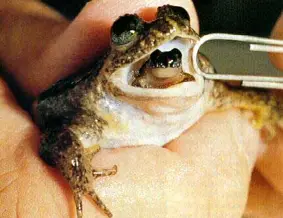Alas, the time has come to end Frog Week. It's been a fun ride; frogs are usually taken for granted, but they really are cool creatures that deserve a lot more love than they receive. Hopefully, you all have been stunned by how strange and wonderful one of the most common types of animal can be.
But we still have one more. Remember how I said that today's would be a little more subtle? Take a looksie at this one and tell me if you notice anything weird about it:

Looks like a fairly normal frog, doesn't it? Look again.

From www.global-greenhouse-warming.com.
Yes, that is a very tiny, immature frog in its mother's mouth. The frog in that picture is one of two types of Gastric-brooding frog (Rheobatrachus). Gastric-brooding frogs are - or were- native to Australia. They have been seen eating insects on land and in the water. They were discovered in 1984 and were among the few aquatic Aussie frogs (read: everything is backwards and on crack in Oz). They were called "platypus frogs" down under simply because they were aquatic.
As the non-Australian name might imply, Gastric-brooding frogs were the only frogs in existence that hatched their young in the mother's stomach. Some of the eggs were eaten; by the time all was said and done, the mother had approximately 21 young in her belly. The non-digested eggs were coated with a substance called prostaglandin E2, which turned off the mother frog's stomach acid. The babies emerged not as tadpoles, but as juvenile frogs. Reminder: The last frog we saw with highly-developed young was the pipa toad, whose babies emerged from her back in a fashion akin to Gremlins without any fluffy fur. Yeah, reptilian parthenogenesis doesn't hold a candle to the sheer weirdness amphibians can do to reproduce.
If you have been paying attention to the grammar of my paragraphs, 1. you're probably a linguist and 2. you will notice that many of the verbs concerning these frogs were in the past tense. These frogs are either extinct or very, very endangered, depending on whose list you check. They were officially discovered in 1984; the Southern variety may have gone out of existence before then, and the last Northern individual was seen sometime in the '80's. We thought the pearly tree frog was elusive; at least we are fairly sure that it still exists. The reasons for these frogs going extinct are multifold, but fungal infection and habitat loss are the most commonly cited causes.

This frog and the pearly tree frog both show how fragile amphibians can be. That's a shame, seeing as they're crucial to many ecosystems and often beautiful to look at. With countless amphibian species vanishing right under our noses, this year, make a resolution to give them their due.
But we still have one more. Remember how I said that today's would be a little more subtle? Take a looksie at this one and tell me if you notice anything weird about it:

Looks like a fairly normal frog, doesn't it? Look again.

From www.global-greenhouse-warming.com.
Yes, that is a very tiny, immature frog in its mother's mouth. The frog in that picture is one of two types of Gastric-brooding frog (Rheobatrachus). Gastric-brooding frogs are - or were- native to Australia. They have been seen eating insects on land and in the water. They were discovered in 1984 and were among the few aquatic Aussie frogs (read: everything is backwards and on crack in Oz). They were called "platypus frogs" down under simply because they were aquatic.
As the non-Australian name might imply, Gastric-brooding frogs were the only frogs in existence that hatched their young in the mother's stomach. Some of the eggs were eaten; by the time all was said and done, the mother had approximately 21 young in her belly. The non-digested eggs were coated with a substance called prostaglandin E2, which turned off the mother frog's stomach acid. The babies emerged not as tadpoles, but as juvenile frogs. Reminder: The last frog we saw with highly-developed young was the pipa toad, whose babies emerged from her back in a fashion akin to Gremlins without any fluffy fur. Yeah, reptilian parthenogenesis doesn't hold a candle to the sheer weirdness amphibians can do to reproduce.
If you have been paying attention to the grammar of my paragraphs, 1. you're probably a linguist and 2. you will notice that many of the verbs concerning these frogs were in the past tense. These frogs are either extinct or very, very endangered, depending on whose list you check. They were officially discovered in 1984; the Southern variety may have gone out of existence before then, and the last Northern individual was seen sometime in the '80's. We thought the pearly tree frog was elusive; at least we are fairly sure that it still exists. The reasons for these frogs going extinct are multifold, but fungal infection and habitat loss are the most commonly cited causes.

This frog and the pearly tree frog both show how fragile amphibians can be. That's a shame, seeing as they're crucial to many ecosystems and often beautiful to look at. With countless amphibian species vanishing right under our noses, this year, make a resolution to give them their due.

No comments:
Post a Comment